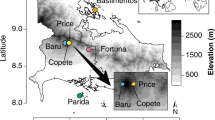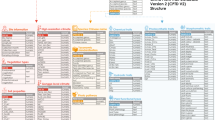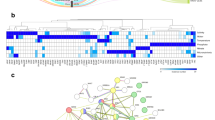Abstract
We demonstrate that native grass species from coastal and geothermal habitats require symbiotic fungal endophytes for salt and heat tolerance, respectively. Symbiotically conferred stress tolerance is a habitat-specific phenomenon with geothermal endophytes conferring heat but not salt tolerance, and coastal endophytes conferring salt but not heat tolerance. The same fungal species isolated from plants in habitats devoid of salt or heat stress did not confer these stress tolerances. Moreover, fungal endophytes from agricultural crops conferred disease resistance and not salt or heat tolerance. We define habitat-specific, symbiotically-conferred stress tolerance as habitat-adapted symbiosis and hypothesize that it is responsible for the establishment of plants in high-stress habitats. The agricultural, coastal and geothermal plant endophytes also colonized tomato (a model eudicot) and conferred disease, salt and heat tolerance, respectively. In addition, the coastal plant endophyte colonized rice (a model monocot) and conferred salt tolerance. These endophytes have a broad host range encompassing both monocots and eudicots. Interestingly, the endophytes also conferred drought tolerance to plants regardless of the habitat of origin. Abiotic stress tolerance correlated either with a decrease in water consumption or reactive oxygen sensitivity/generation but not to increased osmolyte production. The ability of fungal endophytes to confer stress tolerance to plants may provide a novel strategy for mitigating the impacts of global climate change on agricultural and native plant communities.
Similar content being viewed by others
Log in or create a free account to read this content
Gain free access to this article, as well as selected content from this journal and more on nature.com
or
References
Alpert P . (2000). The discovery, scope, and puzzle of desiccation tolerance in plants. Plant Ecol 151: 5–17.
Apel K, Hirt H . (2004). Reactive oxygen species: metabolism, oxidative stress, and signal transduction. Annu Rev Plant Biol 55: 373–399.
Arnold EA, Mejia LC, Kyllo D, Rojas E, Maynard Z, Robbins N et al. (2003). Fungal endophytes limit pathogen damage in a tropical tree. Proc Natl Acad Sci USA 100: 15649–15654.
Arx JAv . (1981). The Genera of Fungi Sporulating in Pure Culture. J Cramer: Vaduz, 424pp.
Barnett HL, Hunter BB . (1998). Illustrated Genera of Imperfect Fungi. American Phytopathology Society: St Paul, 240pp.
Bartels D, Sunkar R . (2005). Drought and salt tolerance in plants. Crit Rev Plant Sci 24: 23–58.
Bohnert HJ, Nelson DE, Jensen RG . (1995). Adaptations to environmental stresses. Plant Cell 7: 1099–1111.
Bray EA . (1997). Plant responses to water deficit. Trends Plant Sci 2: 48–54.
Carroll G . (1988). Fungal endophytes in stems and leaves: from latent pathogen to mutualistic symbiont. Ecology 69: 2–9.
Chaw S, Chang C, Chen H, Li W . (2004). Dating the monocot–dicot divergence and the origin of core eudicots using whole chloroplast genomes. J Mol Evol 58: 424–441.
Farr DF, Bills GF, Chamuris GP, Rossman AY . (1989). Fungi on Plants and Plant Products in the United States. APS Press: St Paul, 1252pp.
Freeman S, Rodriguez RJ . (1993). Genetic conversion of a fungal plant pathogen to a nonpathogenic, endophytic mutualist. Science 260: 75–78.
Ganley RJ, Brunsfeld SJ, Newcombe G . (2004). A community of unknown, endophytic fungi in western white pine. Proc Natl Acad Sci USA 101: 10107–10112.
Henson JM, Redman RS, Rodriguez RJ, Stout R . (2005). Fungi in Yellowstone's geothermal soils and plants. Yellowstone Sci 13: 25–30.
Imbert E, Houle G . (2000). Ecophysiological differences among Leymus mollis populations across a subarctic dune system caused by environmental, not genetic, factors. New Phytol 147: 601–608.
Krings M, Taylor TN, Hass H, Kerp H, Dotzler N, Hermsen EJ . (2007). Fungal endophytes in a 400-million-yr-old land plant: infection pathways, spatial distribution, and host responses. New Phytol 174: 648–657.
Leone A, Perrotta C, Maresca B . (2003). Plant tolerance to heat stress: current strategies and new emergent insight. In: di Toppi LS, Pawlik-Skowronska B (eds). Abiotic Stresses in Plants. Kluwer Academic Pub: London, pp 1–22.
Leslie JF, Summerell BA . (2005). The Fusarium Laboratory Manual. Blackwell Publishing: Ames, 400pp.
Lewis DH . (1985). Symbiosis and mutualism: crisp concepts and soggy semantics. In: Boucher DH (ed). The Biology of Mutualism. Croom Helm Ltd: London, pp 29–39.
Maggio A, Bressan RA, Ruggiero C, Xiong L, Grillo S . (2003). Salt tolerance: placing advances in molecular genetics into a physiological and agronomic context. In: di Toppi LS, Pawlik-Skowronska B (eds). Kluwer Academic Pub: London, pp 53–70.
Márquez LM, Redman RS, Rodriguez RJ, Roossinck MJ . (2007). A virus in a fungus in a plant—three way symbiosis required for thermal tolerance. Science 315: 513–515.
O'Donnell K, Kistler HC, Tacke BK, Casper HC . (2000). Gene genealogies reveal global phylogeographic structure and reproductive isolation among lineages of Fusarium graminearum, the fungus causing wheat scab. Proc Natl Acad Sci USA 97: 7905–7910.
Petrini O . (1996). Ecological and physiological aspects of host-specificity in endophytic fungi. In: Redlin SC, Carris LM (eds). Endophytic Fungi in Grasses and Woody Plants. APS Press: St Paul, pp 87–100.
Pirozynski KA, Malloch DW . (1975). The origin of land plants a matter of mycotrophism. Biosystems 6: 153–164.
Read DJ . (1999). Mycorrhiza—the State of the Art. In: Varma A, Hock B (eds). Mycorrhiza. Springer-Verlag: Berlin, pp 3–34.
Redecker D, Kodner R, Graham LE . (2000). Glomalean fungi from the Ordovician. Science 289: 1920–1921.
Redman RS, Dunigan DD, Rodriguez RJ . (2001). Fungal symbiosis: from mutualism to parasitism, who controls the outcome, host or invader? New Phytol 151: 705–716.
Redman RS, Freeman S, Clifton DR, Morrel J, Brown G, Rodriguez RJ . (1999). Biochemical analysis of plant protection afforded by a nonpathogenic endophytic mutant of Colletotrichum magna. Plant Physiol 119: 795–804.
Redman RS, Rossinck MR, Maher S, Andrews QC, Schneider WL, Rodriguez RJ . (2002a). Field performance of cucurbit and tomato plants infected with a nonpathogenic mutant of Colletotrichum magna (teleomorph: Glomerella magna; Jenkins and Winstead). Symbiosis 32: 55–70.
Redman RS, Sheehan KB, Stout RG, Rodriguez RJ, Henson JM . (2002). Thermotolerance conferred to plant host and fungal endophyte during mutualistic symbiosis. Science 298: 1581.
Rodriguez RJ . (1993). Polyphosphates present in DNA preparations from filamentous fungal species of Colletotrichum inhibits restriction endonucleases and other enzymes. Anal Biochem 209: 1–7.
Rodriguez RJ, Redman RS, Henson JM . (2004). The role of fungal symbioses in the adaptation of plants to high stress environments. Mitigation and Adaptation Strategies for Global Change 9: 261–272.
Rodriguez RJ, Redman RS, Henson JM . (2005). Symbiotic lifestyle expression by fungal endophytes and the adaptation of plants to stress: unraveling the complexities of intimacy. In: Dighton J, Oudemans P, White J (eds). The Fungal Community: Its Organization And Role In The Ecosystem. Taylor & Francis/CRC Press: Boca Raton, pp 683–696.
Rodriguez RJ, Yoder OC . (1991). A family of conserved repetitive DNA elements from the fungal plant pathogen Glomerella cingulata (Colletotrichum lindemuthianum). Exp Mycol 15: 232–242.
Ryan F . (2002). Darwin's Blind Spot: Evolution Beyond Natural Selection. Houghton Mifflin Co.: Boston, MA, USA, 310.
Schardl SL, Leuchtmann A, Spiering MJ . (2004). Symbioses of grasses with seedborne fungal endophytes. Annu Rev Plant Biol 55: 315–340.
Schulz B, Rommert AK, Dammann U, Aust HJ, Strack D . (1999). The endophyte–host interaction: a balanced antagonism? Mycol Res 10: 1275–1283.
Schulz BJE . (2006). Mutualistic interactions with fungal root endophytes. In: Schulz BJE, Boyle CJC, Sieber TN (eds). Microbial Root Endophytes. Springer-Verlag: Berlin, pp 261–280.
Smallwood MF, Calvert CM, Bowles DJ . (1999). Plant Responses to Environmental Stress. BIOS Scientific Publishers Limited: Oxford, 224pp.
Tanaka A, Christensen MJ, Takemoto D, Park P, Scott B . (2006). Reactive oxygen species play a role in regulating a fungus—perennial ryegrass mutualistic interaction. Plant Cell 18: 1052–1066.
Tu JC . (1985). An improved Mathur's medium for growth, sporulation, and germination of spores of Colletotrichum lindemuthianum. Microbios 44: 87–93.
Tuberosa R, Grillo S, Ellis RP . (2003). Unravelling the genetic basis of drought tolerance in crops. In: di Toppi LS, Pawlik-Skowronska B (eds). Kluwer Academic Pub: London, pp 71–122.
Vaughn KC, Duke SO . (1983). In situ localization of the sites of paraquat action. Plant Cell Environ 6: 13–20.
Waller F, Achatz B, Baltruschat H, Fodor J, Becker K, Fischer M et al. (2005). The endophytic fungus Piriformospora indica reprograms barley to salt-stress tolerance, disease resistance, and higher yield. Proc Natl Acad Sci USA 102: 13386–13391.
Wang W, Vincur B, Altman A . (2003). Plant responses to drought, salinity and extreme temperatures: towards genetic engineering for stress tolerance. Planta 218: 1–14.
White TJ, Bruns T, Lee S, Taylor J . (1990). Amplification and direct sequencing of fungal ribosomal RNA genes for phylogenetics. In: Innis MA, Gelfand DH, Sninsky JJ, White TJ (eds). PCR Protocols: A Guide to Methods and Applications. Academic Press, INC.: San Diego, pp 315–322.
Wolfe KH, Gouy M, Yang Y, Sharp PM, Li W . (1989). Date of the monocot–dicot divergence estimated from chloroplast DNA sequence data. Proc Natl Acad Sci USA 86: 6201–6205.
Yang YW, Lai KN, Tai PY, Li WH . (1999). Rates of nucleotide substitution in angiosperm mitochondrial DNA sequences and dates of divergence between Brassica and other angiosperm lineages. J Mol Evol 48: 597–604.
Acknowledgements
We thank Jill Walters, Rhonda Schmidt, Jeff Duda, Dr Julio Harvey, Dr Richard Stout, Ida Benson and Jean Cornish with sample processing, sample and statistical analysis and assistance establishing field experiments. This project was made possible by the permission, assistance and guidelines of YNP and the UW Cedar Rocks Biological Preserve. This work was supported by the US Geological Survey, and support funding from NSF (0414463) and US/IS BARD (3260–01C).
Author information
Authors and Affiliations
Corresponding author
Rights and permissions
About this article
Cite this article
Rodriguez, R., Henson, J., Van Volkenburgh, E. et al. Stress tolerance in plants via habitat-adapted symbiosis. ISME J 2, 404–416 (2008). https://doi.org/10.1038/ismej.2007.106
Received:
Revised:
Accepted:
Published:
Issue date:
DOI: https://doi.org/10.1038/ismej.2007.106
Keywords
This article is cited by
-
The relationship between atmospheric particulate matter, leaf surface microstructure, and the phyllosphere microbial diversity of Ulmus L.
BMC Plant Biology (2024)
-
A combined compost, dolomite, and endophyte addition is more effective than single amendments for improving phytorestoration of metal contaminated mine tailings
Plant and Soil (2024)
-
Halophytic Bacterial Endophyte Microbiome from Coastal Desert-Adapted Wild Poaceae Alleviates Salinity Stress in the Common Wheat Triticum aestivum L.
Current Microbiology (2024)
-
Targeted regulation of the microbiome by green manuring to promote tobacco growth
Biology and Fertility of Soils (2024)
-
Genetic Mapping of the Root Mycobiota in Rice and its Role in Drought Tolerance
Rice (2023)



